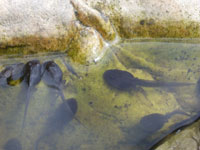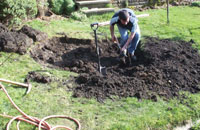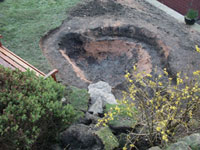
Get digging your wildlife pond!
(But read this first!)
The advice given here assumes that you are going to have a wildlife pond and use a flexible liner. I know very little about designing ponds for koi fish, apart from the fact that they seem to require constant attention, are costly and require an extensive filtration system. Go to an aquatic centre and find out how much a koi carp will cost you. Frogspawn, frogs, newts, pond skaters and dragonflies are all free!
|
Mark out the shape of your pond using a thick rope or hosepipe for smooth curves. Don't make the shape too 'fussy' as it will be difficult to make your liner fit neatly. To assist with water clarity, make your pond as big as possible and avoid a deeply shaded site.
|
|
|
|
A shelf 20-30cm (8-12" deep) and 30cm (12") wide round part of the inside of your pond will enable you to grow marginal plants in baskets and will probably be used by frogs as a suitable place to lay their frogspawn. |
Your wildlife pond needs gently sloping slides to enable animals and birds to drink and bathe safely and to allow your frogs and froglets an easy escape route from your pond. Stones projecting above the surface give developing tadpoles an opportunity to soak up the sun! |
 |
Try to ensure a depth of about 45cm (18") to enable your frogs to hibernate in the mud at the bottom and to allow you to plant 'deep water aquatic' plants.
Check all round with a board and spirit level to ensure that the surface of your pond is completely horizontal. Add or remove earth as necessary. Remove all large stones and roots to avoid damaging the liner.
Line the sides and base with a 2-3cm (1") thick layer of damp sand.
Construction Pages
Page 1 Some considerations |
Page 2 Wildlife or Fish? |
Page 3 Pond Materials |
You are on page 4 of 8 |
Page 5 Pond Liner |
Page 6 Finishing Touches |
Page 7 Plants - oxygenators |
Page 8 Plants - Marginals |
Frogs, frogspawn & tadpoles - page [1]
[2]![]() Main
Pond Page
Main
Pond Page

